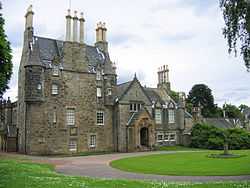Lauriston Castle
| Lauriston Castle | |
|---|---|
|
Edinburgh, Scotland NT2021676093 | |
|
Lauriston Castle from the south | |
| Type | L-plan tower house with a Jacobean range |
| Site information | |
| Owner | the city of Edinburgh |
| Open to the public | Yes |
| Site history | |
| Built | c. 1590 |
| Built by | probably Archibald Napier, 7th Laird of Merchiston |
| In use | 16th century to 21st century |
| Materials | Stone |
Lauriston Castle is a 16th-century tower house with 19th-century extensions overlooking the Firth of Forth, in Edinburgh, Scotland. It lies on Cramond Road South, between Cramond and Davidson's Mains. The substantial grounds, Lauriston Castle Gardens, operate as a local park.
History
A Lauriston Castle stood on this site in medieval times but was almost totally destroyed in the raids on Edinburgh in 1544 by the earl of Hertford.[1]
A tower house was re-built around 1590 by Sir Archibald Napier of Merchiston, father of John Napier, for his younger son, also named Archibald. Later, it was the home of John Law (1671–1729), the economist, Right Hon. Andrew Lord Rutherfurd (1791–1854), and Thomas Macknight Crawfurd of Cartsburn and Lauriston Castle, 8th Baron of Cartsburn from 1871 to 1902. In 1827, Thomas Allan, a banker and mineralogist, commissioned William Burn (1789–1870) to extend the house in the Jacobean style.

William Robert Reid, proprietor of Morison & Co., an Edinburgh cabinetmaking business, acquired Lauriston Castle in 1902, installed modern plumbing and electricity, and he and his wife Margaret filled the house with a collection of fine furniture and artwork. The Reids, being childless, left their home to Scotland on the condition that it should be preserved unchanged. The City of Edinburgh has administered the house since Mrs Reid's death in 1926, which today offers a glimpse of Edwardian life in a Scottish country house.
In 1905, during one of its numerous refurbishments, a stone carving of an astrological horoscope was installed in the outer wall, on the southwest corner. The horoscope was reputedly done by John Napier for his brother. It can be seen in some pictures on the front wall, beneath the left-most stair tower, near the ground.
Design

Lauriston Castle was originally a four-storey, stone L plan tower house, with a circular stair tower, with two storey angle turrets complete with gun loops. A Jacobean range was added in 1827, to convert it to a country manor. This was designed by the prominent architect William Burn.
The majority of the interior is Edwardian.
Gardens
The gardens at Lauriston include a notable Japanese garden of one hectare. The garden, built by Takashi Sawano, and dedicated as the Edinburgh-Kyoto Friendship Garden, opened in August 2002.[2]
At the back of the castle there are beautiful views of the Firth of Forth, which are enjoyed by members of the Edinburgh Croquet Club on the three croquet lawns laid out on the castle grounds between 1950 and 1955.
To the east the gardens include some excellent mature examples of monkey puzzle trees (Araucaria araucana).
The site is also famed for its bluebell wood.
Ghost
Lauriston Castle, like so many other Scottish castles, is reputedly haunted. It is said that the sound of ghostly footsteps can be heard.[3]
References
- ↑ Buildings of Scotland: Edinburgh by Gifford McWilliam and Walker
- ↑ "Public Japanese Gardens: UK and Ireland Survey". Journal of Japanese Gardening No. 35, September/October 2003. accessed 16 October 2006.
- ↑ "Looking for ghosts? Try the usual haunts" The Supernatural World
External links
- Description of Lauriston with photo
- Lauriston Castle official website
- Edinburgh Croquet Club
- Friendship Garden
- Engraving of Lauriston Castle by James Fittler in the digitised copy of Scotia Depicta, or the antiquities, castles, public buildings, noblemen and gentlemen's seats, cities, towns and picturesque scenery of Scotland, 1804 at National Library of Scotland
| Wikimedia Commons has media related to Lauriston Castle. |
